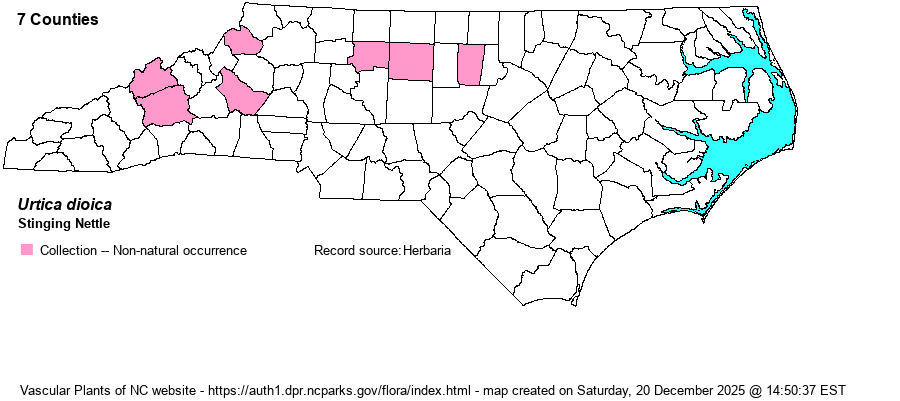| Author | L. | |
| Distribution | Mostly Mountains, also northern Piedmont. The specimens from the Mountains are from natural habitats, notably along the French Broad River. Interestingly, one specimen at herbarium IND from Madison County (Radford et al. 45159) was annotated to the native subspecies gracilis, whereas duplicates at other herbaria were annotated to the alien subspecies dioica. FNA maps both along the Appalachians south to NC, TN, and GA. To resolve this quandary it will be necessary to examine specimens in hand. Meanwhile, website editors will map both taxa in the Mountains, with non-natives in the Piedmont.
Native of Eurasia; in N.A. southern Greenland to Ont., south to FL and OK; also CA to WA. | |
| Abundance | Apparently rare, but may be numerous where found -- such as along or near the French Broad River. | |
| Habitat | Montane sites are along the French Broad River (Madison and Buncombe counties), fence row (Watauga Co.), and moist wooded flat between creeks (Burke Co.). | |
| Phenology | Flowering May-July. | |
| Identification | This nettle is rangey, branched, erect or sprawling on other plants, and may reach 6 feet or more. Leaves vary from narrowly triangular to ovate and sharply toothed, generally the larger ones lower on stem. Stem, branches, and leaves have variable amounts of normal hairs and stinging hairs, with species dioica having the most and the native species gracilis the least (see Weakley 2018 or FNA 1997 for details). Flowers are tiny and produced on loose to tight, elongate clusters from leaf axils. Male and female flowers occur on different plants in dioica, but mostly on the same plant in gracilis. U. gracilis tends to have longer and/or narrower leaves than are found in U. dioica. | |
| Taxonomic Comments | Treated as dioica subspecies dioica in FNA.
| |
| Other Common Name(s) | | |
| State Rank | SE * | |
| Global Rank | G5 | |
| State Status | | |
| US Status | | |
| USACE-agcp | FAC link |
| USACE-emp | FACU link |

